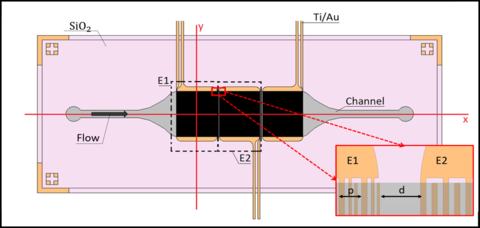Summary
Applications such as single cell measurements of protein content (e.g., antibodies, surface markers), low analyte concentration (e.g., biomarkers), and implantable and external pumps, require reliable and accurate measurement of low flow rates. In the case of implantable and external pumps used for continuous injection of drugs, inaccurate measurements can be fatal. We are developing surface acoustic wave (SAW) sensors, which can be designed to measure a broad range of flow rates. Other flow-sensing modalities require expensive external equipment (e.g., optical flow meters) or the addition of tracers to the fluid (e.g., doppler shift, time of flight, or optical). In contrast, SAW sensors are compact and do not require the addition of a tracer to measure flow. Our goal is to develop label-free, reliable, and accurate SAW flow sensors to produce SI traceable measurements of microfluidic flow.
Description

Figure 1. A surface acoustic wave (SAW) sensor used for flow detection in microfluidic systems. The sensor is comprised of 3 sets of interdigitated transducers (ITDs), each with 32 pair of fingers and a pitch of 80 μm. The IDTs are fabricated on a lithium niobate (LiNbO3) piezoelectric substrate with a polydimethylsiloxane (PDMS) microchannel placed on top of the IDTs for a complete assembled flow sensor.
As part of our NIST-on-a-Chip efforts, we are developing strategies to measure local flow in microfluidic systems. This project will develop label-free flow sensors using surface acoustic waves embedded in microfluidic devices. In this approach, an electromechanical transducer is placed on a piezoelectric substrate, and a surface acoustic wave is generated, propagating from the emitter to the receiver. The interaction between the fluid and acoustic waves yields a decrease in magnitude (damping) and phase-shift of the surface acoustic wave. Thus, the measured acoustic power and phase at the receiver are directly correlated to the flow rate. This technology covers a broad range of flow rates from 1 μL/min to 10 mL/min. In addition to exhibiting a wide dynamic range, the SAW-based flow meter is easier to fabricate and integrate into microfluidic devices. We are currently developing finite element models to understand the observed responses in these devices. And, we are developing new designs to improve outcomes.
Research Opportunities
NRC/NIST Postdoctoral Fellowship
- 2-year fellowship
- Sponsored by the National Research Council
- Application requires an original research proposal
- Application deadlines: February 1 and August 1
- Stipend - $ 74,950/year; Travel Allotment - $3,000; Other benefits
- Application deadlines are Feb. 1 and Aug. 1 of each year
- US citizenship required
Please contact Dr. Darwin R. Reyes at darwin.reyes [at] nist.gov (darwin[dot]reyes[at]nist[dot]gov) if interested in applying for this fellowship.
- Dr. Reyes NRC-NIST Research Opportunity Description
- NIST NRC Postdoctoral Research Associateships Program
- Research Associateship Programs - National Academies of Sciences, Engineering and Medicine
Selected Publications
- A. Quelennec, J.J. Gorman and D.R. Reyes Amontons-Coulomb-like slip dynamics in acousto-microfluidics, Nature Communications, 2022, 13, 1429.
- A. Quelennec, J.J. Gorman and D.R. Reyes*, Frequency Tunable Label-Free Surface Acoustic Wave-Based Flow Sensor, In Proceedings of Micro Total Analysis Systems 2020, 158-159.

